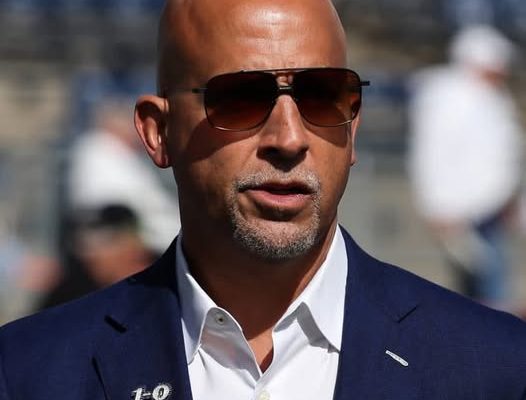James Franklin’s name has long been synonymous with stability and success in college football, but recent news about his buyout at Penn State has reignited debates about whether the investment in him is truly justified. This season, Franklin’s buyout stands as one of the highest in the sport, reportedly reaching figures that have left fans and analysts alike questioning the value the program receives in return. At a time when college football programs are scrutinizing every dollar spent on coaching contracts, Franklin’s situation offers a fascinating case study into the balance between financial commitment and on-field performance.
Franklin took over the Penn State program in 2014, following the end of Bill O’Brien’s tenure, with high expectations. The program, recovering from a tumultuous period marked by NCAA sanctions and off-field controversies, needed a steady hand to restore its credibility and competitiveness. From the outset, Franklin brought a blend of recruiting acumen, motivational leadership, and offensive innovation that appealed to both players and fans. He quickly earned a reputation as a coach who could rebuild programs, having previously done similar work at Vanderbilt, where he led the Commodores to consecutive bowl victories—a feat that had been rare in recent memory for the program.
When evaluating Franklin’s buyout and the corresponding financial investment, one must first consider his track record. During his tenure at Penn State, Franklin has led the Nittany Lions to multiple bowl games, including high-profile appearances that have elevated the program’s national profile. He has consistently fielded competitive teams in the Big Ten, a conference known for its physical play, tactical depth, and rigorous schedule. Franklin’s teams have been characterized by solid defensive schemes, balanced offensive strategies, and the ability to perform under pressure in key conference matchups. Such consistency does not come cheap, and the buyout reflects the premium Penn State places on maintaining that stability.
However, success in college football is often measured not just by consistency but by championships, and therein lies part of the controversy surrounding Franklin’s buyout. While he has delivered strong regular-season records and bowl appearances, critics argue that the team has fallen short in the most critical moments—particularly in games against elite programs or in conference championship opportunities. For a program with national title aspirations, even a single season without a championship appearance can cast doubt on the perceived value of a coach’s compensation. In this context, Franklin’s buyout can be seen as both a reward for past achievements and a hedge against the potential instability that might arise if he were to depart unexpectedly.
Recruiting is another crucial factor when assessing Franklin’s worth. College football success depends heavily on the talent a coach brings into the program. Franklin has consistently delivered strong recruiting classes, attracting high-caliber athletes who often go on to professional careers in the NFL. His ability to develop players both on and off the field enhances the overall reputation of Penn State, making the program more attractive to recruits and fans alike. This aspect of his tenure cannot be understated, as high-level recruiting directly correlates with long-term competitiveness and revenue generation through ticket sales, merchandising, and media deals.
Financially, the decision to offer a high buyout also serves as a strategic tool for retention. In an era where coaching turnover is rampant and programs are willing to pay unprecedented sums to secure elite talent, locking Franklin into a contract with a substantial buyout ensures that other programs will think twice before attempting to lure him away. This stability benefits not only the football program but the university as a whole, as consistent leadership helps maintain brand value, fan engagement, and donor confidence. It is a form of insurance, albeit an expensive one, against the volatility that has plagued other programs in similar situations.
Nevertheless, the optics of Franklin’s buyout have generated considerable debate among fans and analysts. In a world where some programs struggle to meet payroll for support staff or invest in academic resources for student-athletes, paying a coach a buyout that reaches into the tens of millions of dollars can appear disproportionate. Critics question whether the funds allocated toward such a buyout might be better spent improving facilities, investing in player development, or enhancing academic support for athletes. This conversation often touches on broader ethical considerations in college sports, where financial priorities can sometimes clash with institutional missions centered on education and holistic student development.
To further complicate the evaluation, the college football landscape is evolving rapidly. The introduction of the transfer portal, Name, Image, and Likeness (NIL) deals, and increasingly lucrative television contracts have dramatically altered the stakes for coaches. Franklin operates in a competitive market where retaining top talent requires not just a winning record but also adept navigation of these new dynamics. A coach’s ability to manage player expectations, capitalize on NIL opportunities, and recruit in a more fluid landscape has become part of the calculus in determining whether a buyout—and the investment it represents—is justified. Franklin’s capacity to remain relevant in this shifting environment adds another layer of value that may not be immediately apparent in win-loss records alone.
Analyzing the financial impact further, Franklin’s buyout is often framed in terms of risk management. College football is a high-pressure business, and programs are aware that a sudden coaching departure can disrupt recruiting pipelines, destabilize team culture, and affect revenue streams. By committing to a large buyout, Penn State mitigates the risk of losing a coach who has proven capable of maintaining competitive standards. In effect, the university is betting that the long-term benefits of retaining Franklin outweigh the immediate cost of the buyout. While this strategy is not without precedent, it is nonetheless subject to scrutiny, particularly in a landscape where other programs have seen mixed results from similar investments.
From a broader perspective, Franklin’s buyout also reflects market dynamics in college football coaching salaries. Across the nation, programs are increasingly willing to pay premium sums to secure experienced and successful coaches. The size of Franklin’s buyout is therefore not only a function of his individual achievements but also a reflection of supply and demand within the coaching market. Programs that fail to offer competitive compensation risk losing coaches to rivals, which can have cascading effects on program success. In this light, Franklin’s buyout can be understood as both a reward for past success and a strategic necessity in a highly competitive labor market.
The question remains whether the investment has yielded a proportional return. Evaluating Franklin’s tenure involves balancing tangible achievements—such as winning records, bowl appearances, and player development—with intangible benefits like program stability, recruiting strength, and brand enhancement. On the one hand, Franklin has consistently delivered above-average results and maintained Penn State’s position as a respected program within the Big Ten. On the other hand, the absence of a national championship and occasional high-profile losses have fueled skepticism about whether the buyout represents value commensurate with its size. This tension lies at the heart of the debate and underscores the difficulty of quantifying the true worth of a coach in college football.
Fans’ opinions are equally divided. Supporters argue that Franklin has transformed Penn State into a model of consistency, built a culture that attracts top talent, and navigated the program through a challenging era. They see the buyout as a fair reflection of the security and stability he provides. Detractors, however, point to missed opportunities in critical games and question whether the financial commitment aligns with the program’s ultimate aspirations. Social media discussions, sports talk shows, and fan forums abound with analyses, predictions, and critiques, illustrating just how polarizing the question of Franklin’s buyout has become.



